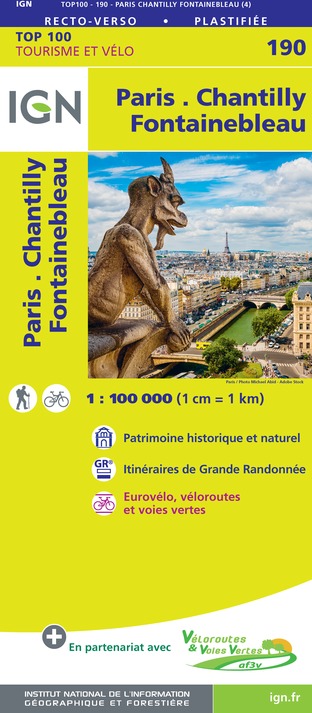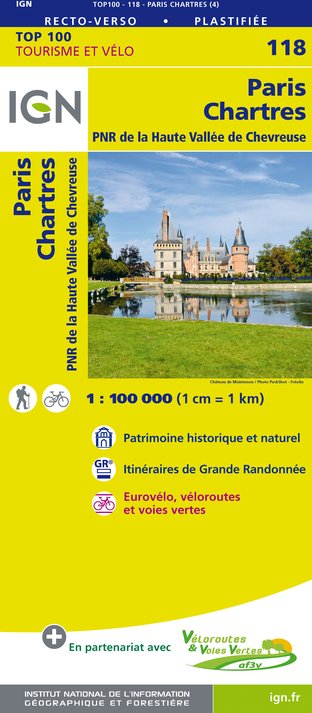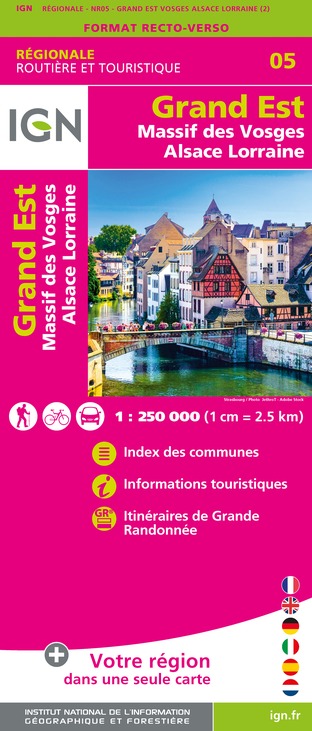Allarme
Allarmi
Tipo di pratica
A piedi
Molto facile
1h
Presentazione
Descrizione
Mappa
Punti di interesse
Sintesi di Cirkwi
Valutazioni e recensioni
Vedi nei dintorni
Passeggiata a Moisenay


Credito : CCBRC
Il breve di Cirkwi
Scopri Moisenay: Un Viaggio Attraverso Patrimonio e Natura
Immagina di passeggiare in un pittoresco villaggio incastonato nella serena Val d'Ancœur, adiacente al maestoso Chateau de Vaux-le-Vicomte e nelle vicinanze di Blandy-les-Tours. Questo è Moisenay, un villaggio che ha brillantemente preservato la sua essenza rurale, offrendo la possibilità di immergersi nel cuore di una valle bucolica. Realizzato dalla Communauté de Communes Brie des Rivières et Châteaux, questo itinerario ti invita a esplorare la splendida campagna, i ponti storici, i vecchi mulini e un ricco patrimonio racchiuso nell'architettura del XII e XIII secolo della Église Saint-Martin. Una fusione di grandeza storica e bellezza naturale ti aspetta per ispirare i tuoi sensi.
Suggerimenti Essenziali sull'Itinerario
Coprendo una distanza di 3,3 chilometri con un modesto dislivello compreso tra i 53 e gli 86 metri, questa passeggiata è accessibile agli appassionati di tutti i livelli. In particolare, il percorso inizia e termina nell'area di parcheggio del complesso sportivo, garantendo convenienza per i visitatori. Il percorso si snoda attraverso il villaggio, attraversando luoghi storici come il Moulin de Pouilly e il Pont de Fer, senza salite impegnative, rendendolo una scelta ideale per una piacevole esplorazione. Non è segnalato, quindi si consiglia agli avventurieri di portare una mappa o utilizzare strumenti di navigazione digitale per un'esperienza senza intoppi.
Suggerimenti Stagionali per gli Esploratori
Indipendentemente dalla stagione, Moisenay offre un'esperienza affascinante. La primavera e l'autunno, con il loro clima mite, sono perfetti per apprezzare la flora in fiore e i toni dorati e nitidi delle foglie. In estate, l'ombra fornita dagli alberi maestosi offre un riposo dal calore, rendendolo un momento ideale per gli amanti del relax. Tuttavia, poiché il percorso prevede attraversamenti di campi e boschi, è importante indossare calzature adatte durante tutto l'anno per navigare comodamente sul terreno. Controlla sempre le previsioni del tempo in anticipo per evitare condizioni impreviste e garantire una visita piacevole.
Moisenay: Un Gioiello Culturale e Storico
Moisenay, incastonato nella regione Île-de-France, rappresenta una testimonianza del patrimonio storico e rurale francese. Fin dalle sue fondamenta, ha assistito a secoli di evoluzione culturale, con l'Église Saint-Martin che simboleggia la grandezza architettonica e la vita spirituale del Medioevo in Seine-et-Marne. Questo villaggio, situato vicino a siti storici cruciali come il Chateau de Vaux-le-Vicomte, funge da museo vivente, invitando gli esploratori a fare un salto indietro nel tempo ed esperire il ricco intreccio della cultura di campagna francese, del suo popolo e del loro legame con la terra.
Guida Climatica per i Visitatori di Moisenay
Godendo di un clima temperato, Moisenay gode di stagioni distinte che offrono fascino unico per i visitatori. Il clima della regione è tipicamente mite, con estati calde e inverni freschi, rendendo la primavera all'autunno il momento ideale per le attività all'aperto. Per assaporare appieno i paesaggi verdi e i siti storici, si consiglia di programmare una visita tra aprile e ottobre. Durante questi mesi, le condizioni meteorologiche sono più favorevoli per camminare, garantendo un'avventura all'aperto confortevole ed arricchente a Moisenay.
Immagina di passeggiare in un pittoresco villaggio incastonato nella serena Val d'Ancœur, adiacente al maestoso Chateau de Vaux-le-Vicomte e nelle vicinanze di Blandy-les-Tours. Questo è Moisenay, un villaggio che ha brillantemente preservato la sua essenza rurale, offrendo la possibilità di immergersi nel cuore di una valle bucolica. Realizzato dalla Communauté de Communes Brie des Rivières et Châteaux, questo itinerario ti invita a esplorare la splendida campagna, i ponti storici, i vecchi mulini e un ricco patrimonio racchiuso nell'architettura del XII e XIII secolo della Église Saint-Martin. Una fusione di grandeza storica e bellezza naturale ti aspetta per ispirare i tuoi sensi.
Suggerimenti Essenziali sull'Itinerario
Coprendo una distanza di 3,3 chilometri con un modesto dislivello compreso tra i 53 e gli 86 metri, questa passeggiata è accessibile agli appassionati di tutti i livelli. In particolare, il percorso inizia e termina nell'area di parcheggio del complesso sportivo, garantendo convenienza per i visitatori. Il percorso si snoda attraverso il villaggio, attraversando luoghi storici come il Moulin de Pouilly e il Pont de Fer, senza salite impegnative, rendendolo una scelta ideale per una piacevole esplorazione. Non è segnalato, quindi si consiglia agli avventurieri di portare una mappa o utilizzare strumenti di navigazione digitale per un'esperienza senza intoppi.
Suggerimenti Stagionali per gli Esploratori
Indipendentemente dalla stagione, Moisenay offre un'esperienza affascinante. La primavera e l'autunno, con il loro clima mite, sono perfetti per apprezzare la flora in fiore e i toni dorati e nitidi delle foglie. In estate, l'ombra fornita dagli alberi maestosi offre un riposo dal calore, rendendolo un momento ideale per gli amanti del relax. Tuttavia, poiché il percorso prevede attraversamenti di campi e boschi, è importante indossare calzature adatte durante tutto l'anno per navigare comodamente sul terreno. Controlla sempre le previsioni del tempo in anticipo per evitare condizioni impreviste e garantire una visita piacevole.
Moisenay: Un Gioiello Culturale e Storico
Moisenay, incastonato nella regione Île-de-France, rappresenta una testimonianza del patrimonio storico e rurale francese. Fin dalle sue fondamenta, ha assistito a secoli di evoluzione culturale, con l'Église Saint-Martin che simboleggia la grandezza architettonica e la vita spirituale del Medioevo in Seine-et-Marne. Questo villaggio, situato vicino a siti storici cruciali come il Chateau de Vaux-le-Vicomte, funge da museo vivente, invitando gli esploratori a fare un salto indietro nel tempo ed esperire il ricco intreccio della cultura di campagna francese, del suo popolo e del loro legame con la terra.
Guida Climatica per i Visitatori di Moisenay
Godendo di un clima temperato, Moisenay gode di stagioni distinte che offrono fascino unico per i visitatori. Il clima della regione è tipicamente mite, con estati calde e inverni freschi, rendendo la primavera all'autunno il momento ideale per le attività all'aperto. Per assaporare appieno i paesaggi verdi e i siti storici, si consiglia di programmare una visita tra aprile e ottobre. Durante questi mesi, le condizioni meteorologiche sono più favorevoli per camminare, garantendo un'avventura all'aperto confortevole ed arricchente a Moisenay.
Generato automaticamente.
IGN Carte

2416SB - MELUN MORMANT
Editore : IGN
Collezione : TOP 25 ET SÉRIE BLEUE
Scala : 1:25 000
13.90€

190 PARIS CHANTILLY FONTAINEBLEAU
Editore : IGN
Collezione : TOP 100
Scala : 1:100 000
8.40€

118 PARIS CHARTRES PNR DE LA HAUTE VALLÉE DE CHEVREUSE
Editore : IGN
Collezione : TOP 100
Scala : 1:100 000
8.40€

119 PARIS SENS PNR DU GÂTINAIS FRANÇAIS
Editore : IGN
Collezione : TOP 100
Scala : 1:100 000
8.40€

D75-95 ÎLE-DE-FRANCE OUEST
Editore : IGN
Collezione : CARTES DÉPARTEMENTALES IGN
Scala : 1:150 000
5.90€

D77 SEINE-ET-MARNE
Editore : IGN
Collezione : CARTES DÉPARTEMENTALES IGN
Scala : 1:150 000
5.90€

NR05 GRAND EST RECTO/VERSO MASSIF DES VOSGES ALSACE LORRAINE
Editore : IGN
Collezione : CARTES RÉGIONALES IGN
Scala : 1:250 000
6.80€

NR04 - GRAND EST RECTO/VERSO ARDENNE CHAMPAGNE
Editore : IGN
Collezione : CARTES RÉGIONALES IGN
Scala : 1:250 000
6.80€

NR03 ÍLE DE FRANCE
Editore : IGN
Collezione : CARTES RÉGIONALES IGN
Scala : 1:250 000
6.80€

NR08 CENTRE-VAL DE LOIRE
Editore : IGN
Collezione : CARTES RÉGIONALES IGN
Scala : 1:250 000
6.80€

EUROPE
Editore : IGN
Collezione : DÉCOUVERTE DES PAYS DU MONDE IGN
Scala : 1:2 500 000
7.00€
Informazioni tecniche
A piedi
Difficoltà
Molto facile
Durata
1h
Dist.
3.3 km
Tipo di pratica
A piedi
Molto facile
1h
Mostra di più
Profilo altimetrico
Punto di partenza
7
Parking du complexe sportif - rue de la Grange
,
77950
Moisenay
Lat : 48.562491Lng : 2.733473
Punti di interesse
Autore dei dati
Valutazioni e recensioni
Da vedere nei dintorni





